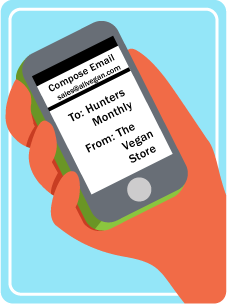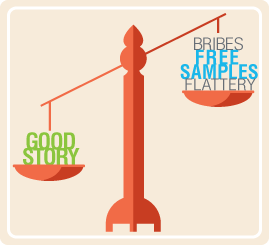As the editor of an outdoor sports monthly magazine – The Outpost – I receive dozens of pitches for media coverage each week. Whether they concern new products, new hunting or fishing shows or (much more commonly) “the most interesting hunting experience anyone has ever had” pitches, I can count on several pitches to be waiting in my email in-box every day.
I am also a content developer and communications specialist for Prejean Creative. This means I have the opportunity to execute content-based marketing programs for our clients which include pitching media outlets for earned media to help leverage this content.
As you can see, in my job (s) I jump from one side of the media desk to the other. When I put on my editor’s hat, I’m deciding whether a story is worth our reader’s time. But when I have on my communications advisor/content developer hat (it’s a little black beret, by the way), I focus on getting our client’s story everywhere their customers might be – including the 10 p.m. TV newscast.
 I’ve been doing this kind of work since I went to work for my little hometown radio station. Okay, I was in high school and we didn’t get a lot of real news there, but I still thought of myself as “the media!” So, I’ve been either pitching or deflecting media pitches forever!
I’ve been doing this kind of work since I went to work for my little hometown radio station. Okay, I was in high school and we didn’t get a lot of real news there, but I still thought of myself as “the media!” So, I’ve been either pitching or deflecting media pitches forever!
In spite of all the new media tools available to reach your audience – social networks, blogs, video blogs, digital newsletters and magazines – generating traditional media such as newspaper and television coverage for your business or that of your client is still an important part of engaging with existing or potential customers. The marketing theory at work here is: if you engage them, they might actually buy something from you.
Six Ways to Garner Media Coverage
In the years I have been in this line of work, I’ve noticed that there is a right way and a wrong way to do this. (See, your mama was right!) In fact, if you have been tasked with managing your company’s public relations, content development, media relations or anything approaching this dark art, there are at least six things that you should keep in mind.
 If you’re mindful of these six things, you will still not get that story about the kitten who came into your store, hopped up on the cash register and rang up a sale on the front page of the daily newspaper. You will, however, have a better shot of getting real news about your company in front of potential customers, and, if you plan it correctly, they might even start following your company on social networks and sign up for your newsletter. In other words, a good content plan, which is based on good stories and good writing, will help you engage customers.
If you’re mindful of these six things, you will still not get that story about the kitten who came into your store, hopped up on the cash register and rang up a sale on the front page of the daily newspaper. You will, however, have a better shot of getting real news about your company in front of potential customers, and, if you plan it correctly, they might even start following your company on social networks and sign up for your newsletter. In other words, a good content plan, which is based on good stories and good writing, will help you engage customers.
Make Sure It’s News
This brings us to the first law of media solicitation. Make sure your story is actually news. Every editor believes she’s over-worked and under-compensated and in most cases, she is. The last thing an editor wants to see or hear, first thing in the morning, is an unsolicited story pitch that’s silly, cute or so self-serving it’s nauseating. Don’t be that person.
Editors don’t care about helping you promote your business. They expect you to pay money to their ad sales people for that. Minor changes in staff size or adding a new product to your offerings may not be newsworthy unless they impact your business substantially.
On the other hand, if your CEO has won an award for her philanthropic efforts or your company has won a multi-million dollar defense contract which will allow it to double in size in the coming year, these are real news stories and you should get your facts straight and consider the next step.
Get the Story Angle Correct
Nothing is more infuriating for an editor than getting a pitch from someone who has obviously never read the publication or seen/heard the news program they are pitching. If you’re pitching a magazine, read it before you send the email query. Who are their readers? How old are these readers? Is it gender specific? Do they even cover hard news? Do they run product reviews? Is the subject matter of your story appropriate for them? Why?
 If you get the answers to these questions, it will inform your story’s angle. You will then be prepared when after you email the editor, you follow up with your phone pitch and he asks the inevitable, impatient question: “OK. What d’ya got?”
If you get the answers to these questions, it will inform your story’s angle. You will then be prepared when after you email the editor, you follow up with your phone pitch and he asks the inevitable, impatient question: “OK. What d’ya got?”
Know the Deadlines
This is the most violated of all media pitching laws. The story may be a monster – full of intrigue, compelling facts and riveting conclusions – but the pitch came after the editor’s deadline and can’t be used. Of course, this drives the editor and the content developer/publicist nuts!
They only stop the presses in movies. The earlier you can get a query in front of a potential media gate-keeper the better. If you’re waiting for some important fact or quote to come in before sending the release, contact the editor, tell him everything you can and ask if it would be acceptable for you to get him the crucial fact as soon as you get it. In most cases, if the story is good, the editor will put together his piece and plug in your last-minute facts.
Every medium has a different deadline. It’s the job of a professional communications specialist to know them all.
Avoid the Tchotchkes – Focus on the Story
Let the story sell itself. Most editors who are worth their salt don’t respond to gimmicks and company paraphernalia. When I receive gifts with a press release, I am immediately suspect of the story.
 The best way to get a story covered is to write a press release or advisory with a compelling, but not bombastic lede paragraph, add 3 to 5 supporting facts and give a brief background on the company. Include a simple email query to the appropriate editor, noting the 2 or 3 reasons why this story should warrant her attention and ask if she would rather you call, text or email for a follow-up.
The best way to get a story covered is to write a press release or advisory with a compelling, but not bombastic lede paragraph, add 3 to 5 supporting facts and give a brief background on the company. Include a simple email query to the appropriate editor, noting the 2 or 3 reasons why this story should warrant her attention and ask if she would rather you call, text or email for a follow-up.
Get to Know the Editors
If it is possible, arrange for a time when you can have a cup of coffee with the news directors or assignments editors for the media you are hoping to interest in stories about your company. It doesn’t have to take more than an hour and it doesn’t have to be at a fancy restaurant. You should also avoid any direct pitch during this first meeting.
Coffee and conversation about your company and what they are looking for in stories should be the only objectives of this meeting. If it’s not possible to get a face-to-face meeting, try using Skype or the old fashioned phone call to get to know these editors and what their objectives are.
Integrate Your Content over All Media
If you’re still using a press release as your only tool for generating media coverage, you’ve been watching too many episodes of Mad Men. There have been many changes in the way content marketing is used in an integrated communications strategy and you should be using them to build customer engagement. In fact the very term “content marketing” is misunderstood by many marketing/public relations practitioners.
Compelling, knowledgeable content, which is packed with facts, quotes and video, when properly deployed, can yield impressive results for customer engagement. It can also lead to additional media coverage. Here’s an example. A highly specialized medical practice hired me to write a series of blogs which are posted every week and tied to a topic that is trending on the popular search engines. My task (and it’s not a simple one) is to tie the trending topic to the search engine keywords and services of the medical practice.
By using appropriate links and tags and by scrupulously choosing a highly trending topic, this “smart content” blog has resulted in a substantial increase in traffic to the practice’s website. We have also aggressively posted links to this blog on their social media which has resulted in even more readership.
Interestingly, it has also resulted in the coverage by the local media in this Top 10 U.S. market. In several cases, the blog post was used as a tool to solicit local and regional television, radio and daily newspaper coverage. Plus, when this story appeared in other media, we produced follow-up blogs which featured the video/audio/print clips from this coverage. Now, the medical editors of the traditional media in this city get RSS feeds of every blog we post.
And Finally…
Make it easy on the poor editors. They know you have a job to do, which is to promote the company you work for, but they have one, too. If you consistently give them real news, written in a professional and concise manner, you will become a valuable resource for them. If you give them hyperbole with no news value, you won’t.
The best advice is to really think it through before the pitch queries start flying out of your laptop. Know their audience and your objectives. With a good pitch and some luck, you might even get that kitten at the cash register story covered.
If you have questions about content marketing or public relations, give us a shout.


